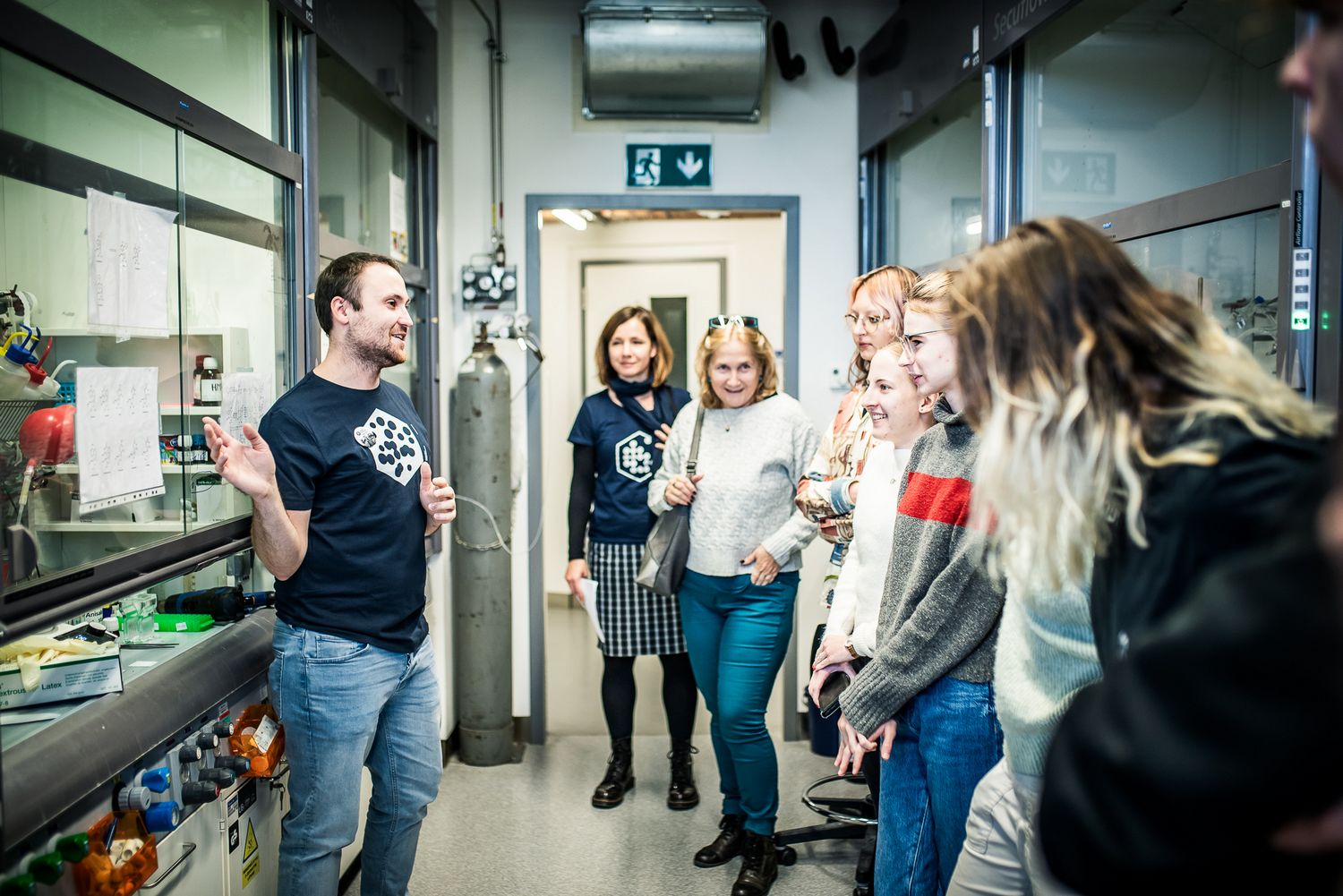Science excursions for schools in English (Week of the Czech Academy of Sciences)

As part of the Week of the Czech Academy of Sciences at IOCB, we are offering guided excursions of our scientific labs for school classes (for students aged 13+) in English.
School groups are invited to visit our laboratories on Friday, November 8, from 9 AM to 12 PM.
See the list of available excursions and register your class below.
If you are interested in our school program conducted in Czech, please go here.
See our English program for the Week of the Czech Academy of Sciences at IOCB Prague here and the complete program in Czech here.
Organization & Registration
Excursions are intended for students from the 8th grade of elementary school and the 3rd grade of 8-year high schools.
For safety and practical reasons, each group is limited to 13 people in total including a teacher. If you plan to come with a larger group of students, please divide them into smaller groups and book a separate program for each. The groups can then rotate to ensure everyone experiences the same presentation.
You can book the program for your class here.
Program
Discover the microscopic world: Exploring objects through various microscopy techniques
Join us for a fun, hands-on look at the amazing world you can’t see with the naked eye! Under different microscopes, we´ll explore all sorts of samples – from everyday items to fascinating tiny creatures. You´ll see how different techniques, like brightfield and fluorescence, reveal surprising details that are otherwise invisible. Whether you´re curious about science or want to see something new, this is your chance to dive into the microscopic world and discover its hidden wonders in a fun, approachable way!
Fluorescence in action – seeing drug development
Fluorescence is the ability of molecules to emit colored light. This phenomenon often accompanies scientists in their first steps toward developing new drugs, which often target enzymes – molecular machines that catalyze chemical reactions in living organisms. In our laboratory, you can see how we use fluorescence to purify enzymes and test potential drugs.
How spicy is it? Ranking a chili pepper’s spiciness
Why are some chili peppers spicier (hotter) than others? Why do chilis burn when you eat them? Learn about the science of chili peppers and how they are ranked based on their spiciness. One bit of advice: Don’t drink the water!
Molecules against blood-feeding parasites
We study the enzymes that parasites need to digest human blood. For example, we’re investigating European ticks, which transmit Lyme disease and encephalitis, as well as tropical blood worms, which cause schistosomiasis in 200 million people. Our goal is to understand how these crucial enzymes work and to develop effective molecules that block their function and can be used as antiparasitic drugs.
Nanoparticles for diagnostics and medicine
The fascinating world of nanotechnology opens new possibilities in diagnosing and treating various diseases. Let’s discover how nanodiamonds are used in modern medicine. You’ll also see how simple black powder can become an advanced sensor for temperature measurements and cancer diagnosis.
NMR and EPR – spies in the world of molecules
When we think of magnetic resonance, we might picture the equipment doctors use to image the human body. But this same technique is used by chemists to reveal the structure of unknown substances, showing how atoms are linked and arranged. In our Nuclear Magnetic Resonance (NMR) and Electron Paramagnetic Resonance (EPR) lab, we’ll explain how the magnetic properties of nuclei and electrons help us investigate molecular structures. You’ll also see the powerful superconducting magnet we use, which has a magnetic field 100,000 times stronger than the Earth's We will explain how molecules communicate with us using their magnetic field and what they reveal about their structure.
Pandemics of the future: Which virus will strike next?
Explore the world of exotic viruses you may not yet know about, but which could have a significant impact on our future. Learn how these viruses threaten not only distant regions of the world but also have the potential to spread globally. We will discuss how these viruses work, where they come from, and why they could trigger the next pandemic.
Playing with fluorescence – glowing cells and solutions
In our laboratory, you’ll discover the fascinating world of fluorescent substances. We’ll show you glowing cells and worms, along with well-known and less familiar fluorescent substances and materials.
"Radioactive" tour
Come and discover the fascinating world of scientific research with radioisotopes! On this tour, we’ll show you modern instruments and methods used to measure and synthesize compounds containing (and not containing) radioactive isotopes. You’ll get a unique look into our laboratories and learn about the research that uses radioactive substances and their applications.
Unknown DNA
When we think of DNA, most of us imagine the classic double-helix associated with genes. However, DNA can also have less traditional functions, which are the focus of our research. We’ll show you how we find short DNA sequences that trigger chemical reactions. You’ll even get to prepare some reactions yourself and observe their progress using techniques we routinely use in our work.
Unveiling the secrets of matter
Ever wonder how fireworks get their colors? Want to see argon plasma hotter than the surface of the Sun? Curious to verify if your ring is really gold? In our lab, we use plasma and light to determine the elemental composition of samples. After exciting the sample with X-rays or heat, it emits characteristic radiation, which tells us about the presence and quantity of each element. Come take a look and delve into the mysteries of analytical chemistry!
Viruses – knowing your enemy
What is a virus, and how do scientists safely work with dangerous ones? We’ll present some of the most interesting viruses and discuss the precautions labs take to protect personnel when handling hazardous pathogens. We’ll also explore how new drugs are developed and ask: Is the virus always the enemy?



